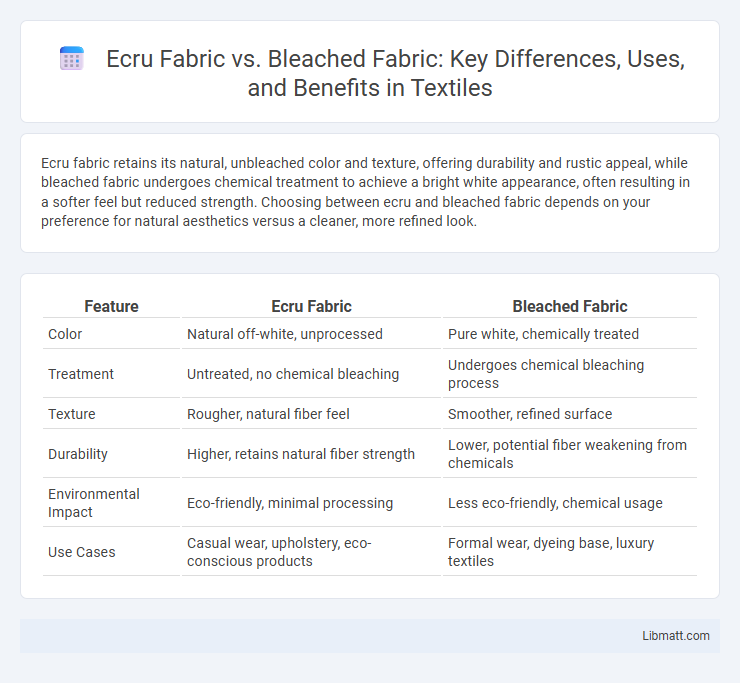Ecru fabric retains its natural, unbleached color and texture, offering durability and rustic appeal, while bleached fabric undergoes chemical treatment to achieve a bright white appearance, often resulting in a softer feel but reduced strength. Choosing between ecru and bleached fabric depends on your preference for natural aesthetics versus a cleaner, more refined look.
Table of Comparison
| Feature | Ecru Fabric | Bleached Fabric |
|---|---|---|
| Color | Natural off-white, unprocessed | Pure white, chemically treated |
| Treatment | Untreated, no chemical bleaching | Undergoes chemical bleaching process |
| Texture | Rougher, natural fiber feel | Smoother, refined surface |
| Durability | Higher, retains natural fiber strength | Lower, potential fiber weakening from chemicals |
| Environmental Impact | Eco-friendly, minimal processing | Less eco-friendly, chemical usage |
| Use Cases | Casual wear, upholstery, eco-conscious products | Formal wear, dyeing base, luxury textiles |
Understanding Ecru Fabric: Definition and Origins
Ecru fabric is a natural, unbleached textile known for its beige or light brown hue, originating from the French word "ecru," meaning raw or unbleached. This fabric maintains its organic color due to minimal processing, preserving the natural fibers and texture, making it an eco-friendly choice. Your selection of ecru fabric emphasizes authenticity and sustainability, contrasting with bleached fabric, which undergoes chemical treatments to achieve a pure white appearance.
What Is Bleached Fabric? Key Characteristics
Bleached fabric is textile material treated with chemical agents such as chlorine or hydrogen peroxide to remove natural color and impurities, resulting in a bright white or light appearance. Key characteristics include enhanced uniformity, a cleaner look, increased softness, and better dye absorption for vivid colors. Understanding these properties helps you choose the right fabric finish for specific applications requiring a pristine or easily customizable surface.
Natural Appearance: Ecru vs Bleached Fabric
Ecru fabric retains its natural, unprocessed color, showcasing a warm, earthy tone that highlights the organic cotton fibers. Bleached fabric undergoes chemical treatment to achieve a bright white finish, resulting in a cleaner but less natural appearance. Consumers seeking authenticity and subtle texture often prefer ecru for its raw, eco-friendly aesthetic.
Manufacturing Process: Unbleached vs Bleached Textiles
Ecru fabric undergoes minimal processing, retaining its natural, unbleached fibers that preserve the original color and texture of the cotton or linen, resulting in a robust and eco-friendly textile. In contrast, bleached fabric is subjected to chemical treatments that strip away impurities and natural pigments, producing a bright white finish but often weakening the fabric's strength and increasing environmental impact. Choosing ecru fabric supports more sustainable manufacturing processes, preserving fiber integrity and reducing chemical use in textile production.
Environmental Impact: Ecru Fabric vs Bleached Fabric
Ecru fabric retains its natural color and requires minimal processing, leading to significantly lower water and chemical usage compared to bleached fabric, which undergoes intensive chemical treatment to achieve its whiteness. The bleaching process releases pollutants and increases carbon emissions, contributing to greater environmental harm. Choosing ecru fabric supports a more sustainable textile industry by reducing your ecological footprint.
Color Consistency and Dyeing Potential
Ecru fabric retains its natural off-white, beige tone, providing greater color consistency across batches due to minimal processing, which results in fewer variations during dyeing. In contrast, bleached fabric undergoes chemical treatment to achieve a uniform white base, enhancing its dyeing potential by allowing vibrant and true-to-hue color absorption. Ecru's natural fibers absorb dyes more unevenly, while bleached fabric consistently produces brighter, more uniform colors ideal for precise textile applications.
Skin Sensitivity and Health Considerations
Ecru fabric, made from unbleached natural fibers, retains its original color and chemical-free state, making it ideal for individuals with sensitive skin or allergies. Bleached fabric undergoes chemical treatments that can leave residues, increasing the risk of irritation or allergic reactions for those with delicate skin. Choosing ecru fabric promotes better skin health by minimizing exposure to harsh chemicals commonly used in bleaching processes.
Durability and Longevity Compared
Ecru fabric, known for its natural, unbleached state, typically retains more of its original fiber strength, resulting in enhanced durability and longer lifespan compared to bleached fabric. Bleached fabric undergoes chemical processes that can weaken fibers, making it more prone to wear and tear over time. When choosing between the two, your decision should consider how the untreated qualities of ecru fabric better preserve durability for extended use.
Popular Uses and Applications
Ecru fabric, prized for its natural, unbleached appearance, is commonly used in home decor items such as curtains, upholstery, and rustic-themed table linens, offering a warm, organic aesthetic. Bleached fabric, known for its crisp white finish, dominates in fashion apparel, medical textiles, and high-end bedding, providing a clean and versatile base ideal for dyeing and printing. Both fabrics serve diverse applications where the choice depends on the desired texture, appearance, and environmental considerations.
Ecru or Bleached: Which Fabric Should You Choose?
Ecru fabric retains its natural, unbleached fibers, offering a rustic, eco-friendly appeal with enhanced durability and minimal chemical processing, making it ideal for sustainable fashion and home decor. Bleached fabric undergoes chemical treatment to achieve a bright, pure white appearance, suitable for formal wear, bedding, and applications requiring a clean, uniform look. Choosing between ecru and bleached fabric depends on desired aesthetics, environmental impact, and intended use, with ecru favored for organic textures and bleached preferred for crisp whiteness.
Ecru Fabric vs Bleached Fabric Infographic

 libmatt.com
libmatt.com